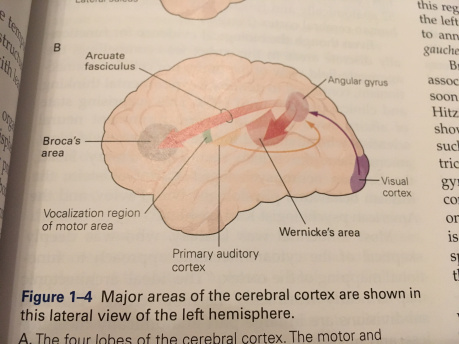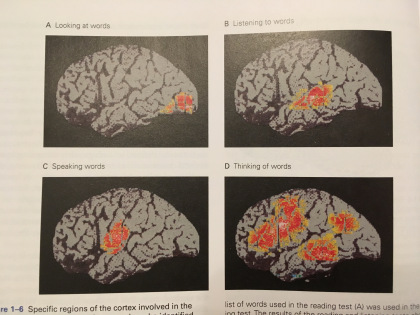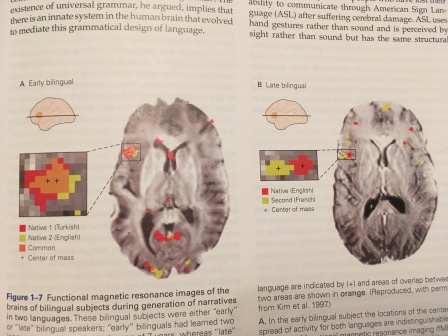The first chapter starts the book off by tracing the historical development of our understanding of the brain. The main idea is that, after many erroneous theories, it is now thought that the brain is organized into physical regions called “functional domains” – each responsible for performing some elementary cognitive task or behavior. And it is these elementary domains, working together, which allow us to perform more complex behaviors.
 Fig. 1 Areas of the brain responsible for language
Fig. 1 Areas of the brain responsible for language
For example, our ability to understand and use language has been localized to Broca’s and Wernicke’s areas, connected via the arcuate fasciculus, with visual information (i.e. reading), arriving from the visual cortex located at the posterior of the brain, and entering the language processing region at the angular gyrus (Fig. 1).
The chapter also shows some nice experimental data demonstrating how these language processing functional domains can act by themselves or as part of a team depending on the complexity of the task that they are carrying out. In Fig. 2, colored patches, representing brain activity are overlaid on top of a grayscale representation of the brain. From this figure, it can be seen that when a person reads, the part of the brain that he uses is the primary visual cortex (responsible for vision) at the posterior of the brain. On the other hand, when person listens to words, it is primarily Wernicke’s area,
 Fig. 2 Brain areas used when looking, listening, speaking, and thinking of words
Fig. 2 Brain areas used when looking, listening, speaking, and thinking of words
responsible for the understanding of language, which shows activity. Speaking, results in Broca’s area, used to transform language into a form that can be written or spoken, to activate. And thinking of words, a very complex behavior, necessitates the use of multiple functional domains including Wernicke’s and Broca’s areas as well as frontal cortex.
I think an interesting idea in this chapter is that the age at which you learn language has an affect on which parts of your brain are active during communication. I have long wondered why languages learned during childhood become second-nature whereas languages learned in adulthood always seem a bit uncomfortable to use, even after decades of experience.
 Fig. 3 Difference in how your brain uses languages learned before and after 7 years old
Fig. 3 Difference in how your brain uses languages learned before and after 7 years old
Fig. 3 shows how languages learned before the age of 7 exist in the same region of the brain whereas languages learned after the age of 7 are physically located in different, but neighboring, regions of the brain. This seems to suggest that this anecdotal observation has some grounding in the differences in brain development that arise during language acquisition.
Advertisements Share this:




